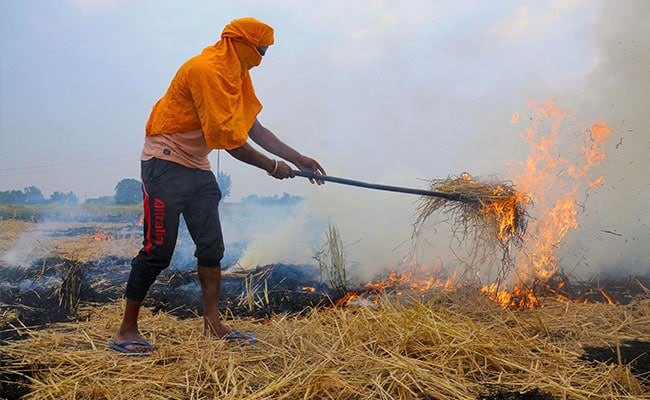
Farm fires will die out in 2-3 years: Punjab Agricultural University V-C
Farmers’ attitudes changing due to massive awareness campaigns; Happy Seeders among many alternatives before them, says Satbir Singh Gosal, Vice-Chancellor of Punjab Agricultural University

Farm fires in Punjab, which release tonnes of soot and smoke into the air during the winter wheat planting season, should end two years from now, Satbir Singh Gosal, Vice-Chancellor of Punjab Agricultural University (PAU), said in an interview to The Federal over Zoom.
Though there were 49,526 farm fires in Punjab till November 23, Gosal drew hope in the 30 per cent decline in fire incidents this year. Last year, there were 71,304 incidents during the wheat planting season till 30 November, according to the Punjab Pollution Control Board.

Gosal said there was partial burning as farmers were planting rice varieties like PR 126 which mature in 123 days compared to 160 days for the late maturing Pusa 44. PR 126 plants remain green even at the time of harvesting and do not burn easily. The early maturing varieties also leave enough time for straw and stubble to be managed without burning.
Straw and stubble: About 20 million tonnes
Punjab farmers planted rice on 31.33 lakh hectares, according to the ministry of agriculture. Each hectare produces about 6.5 tonnes of paddy straw. That’s about 20 million tonnes of straw and stubble. Rice grown on such vast tracts can only be machine-harvested for wheat to be sown in time so that the grain filling stage does not coincide with the rise in temperature towards the end of March. Warm weather at that stage causes grain to shrivel and output to decline.

Combine harvesters leave paddy stalks in the field about 1.5 feet high. After threshing, they also leave behind loose straw. Cutting the stubble and raking and baling the straw and stubble involves additional cost. There are also no takers for the straw. Punjab farmers don’t feed the straw of common rice to cattle unlike in south India. Cattle in Punjab prefer wheat straw as fodder. Burning is a quick solution.
Farmers are changing their attitudes due to massive awareness campaigns, Gosal said. PAU had sent about a thousand students of agricultural sciences to villages on weekends to sensitise them. The university’s Krishi Vigyan Kendras have also been making farmers aware that stubble burning not only causes respiratory illnesses and shortens life but also leads to decreased crop productivity.
Public felicitation of farmers, who practise no-burn agriculture, draws other farmers into the fold through word-of-mouth, Gosal said. About 400 such farmers would be felicitated at the university towards the end of November. This is better than enforcement with penalties, which can cause a backlash.
Also read: Kejriwal, Mann admit responsibility for stubble burning in Punjab
Retaining the straw and stubble on field surfaces and planting wheat through the straw cover (without ploughing the fields) has many advantages. It retains moisture and suppresses weeds (because the soil is not disturbed). The straw degrades over time and enriches the soil, resulting in less use of fertilisers. Burning kills earthworms, beneficial soil microbes and pest hunters like spiders.
Alternative options for farmers
Farmers have many options to choose from. They can plant wheat with seed drills attached to combine harvesters which chop and spread the threshed straw even as they harvest paddy. These are known as the Happy Seeders. PAU had introduced them in 2006. Since wheat sowing is done through rows of standing (hard) stubble, this method also protects wheat plants from stray cattle, whose numbers are menacing.
For those farmers who want faster decomposition of straw, there is the Super Seeder which chops and mixes the straw with soil after paddy is cut with combine harvesters. A newer version is the Smart Seeder, which is a seed drill and fertiliser box attached to a stubble cutter cum chopper.
Also read: Rajasthan, Punjab not doing enough to check stubble burning: Jitendra Singh
There are about 1.2 lakh crop residue management machines in Punjab. According to a state government press release, about 30,000 machines were distributed this year at subsidised rates. There are also hiring centres where the machines can be rented. But a report says these equipment are not being fully utilised.
Despite laws that penalise stubble burning with fines of Rs 2,500 to Rs 15,000 depending on the size of farm holding, farmers continue to burn stubble. No-till agriculture is being practised only on about a fifth of the area under wheat.
Gosal said fungal decomposers are “not really advantageous.” PAU had studied a cocktail of bacteria and fungi developed by itself, Indian Agricultural Research Institute (IARI) and some private companies. All of them failed to make much difference to straw retained on field surfaces. The ideal conditions of a laboratory do not obtain in the open; so the microbes don’t produce the required enzymes in sufficient quantities to degrade straw quickly, the V-C said. IARI recommends that its Pusa Decomposer hastens decomposition when straw sprayed with the mix is mixed with soil. But the degradation happens naturally in soil and there is no need to add the decomposer, Gosal underlined.

